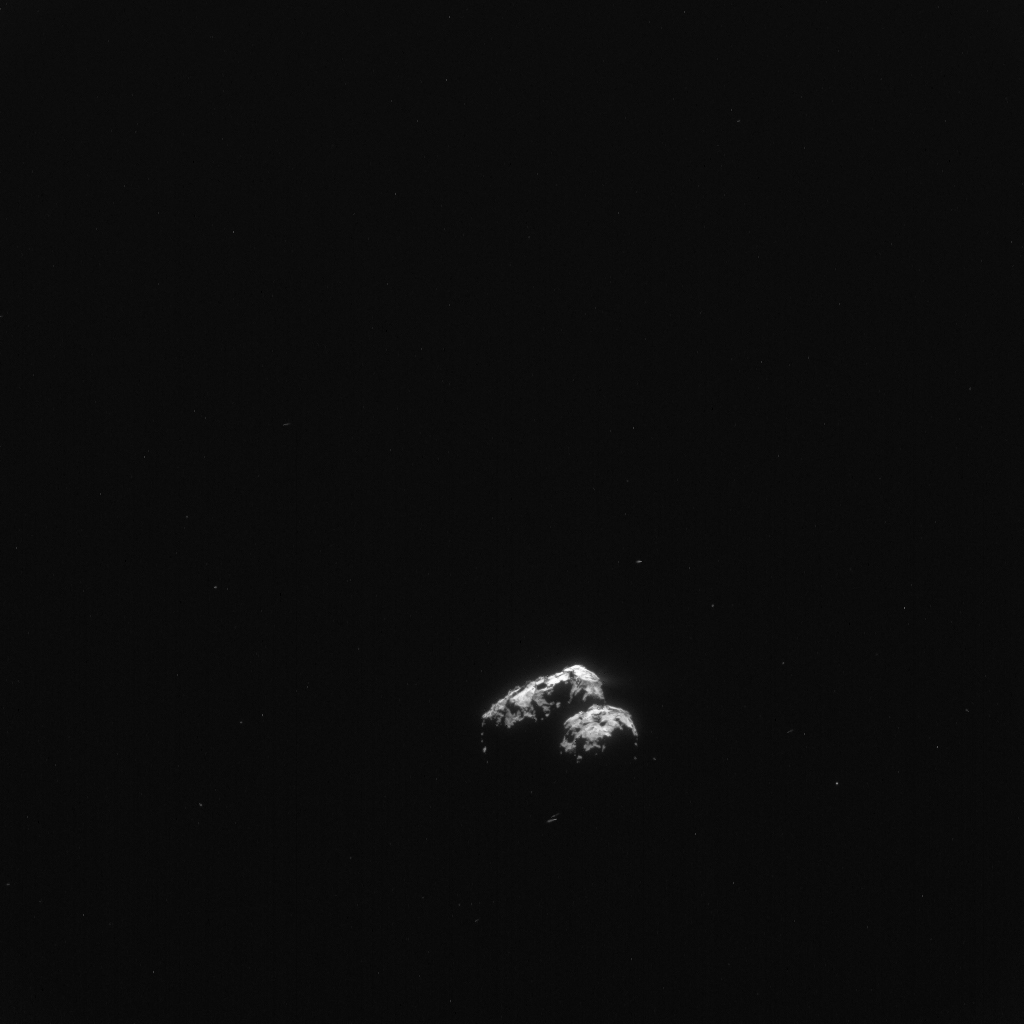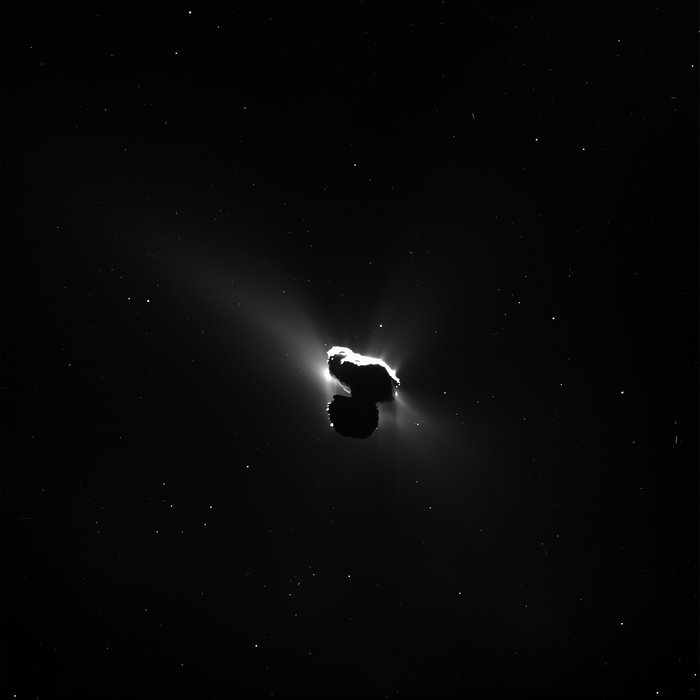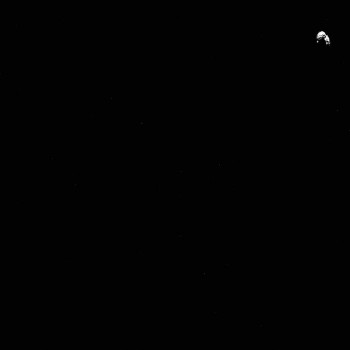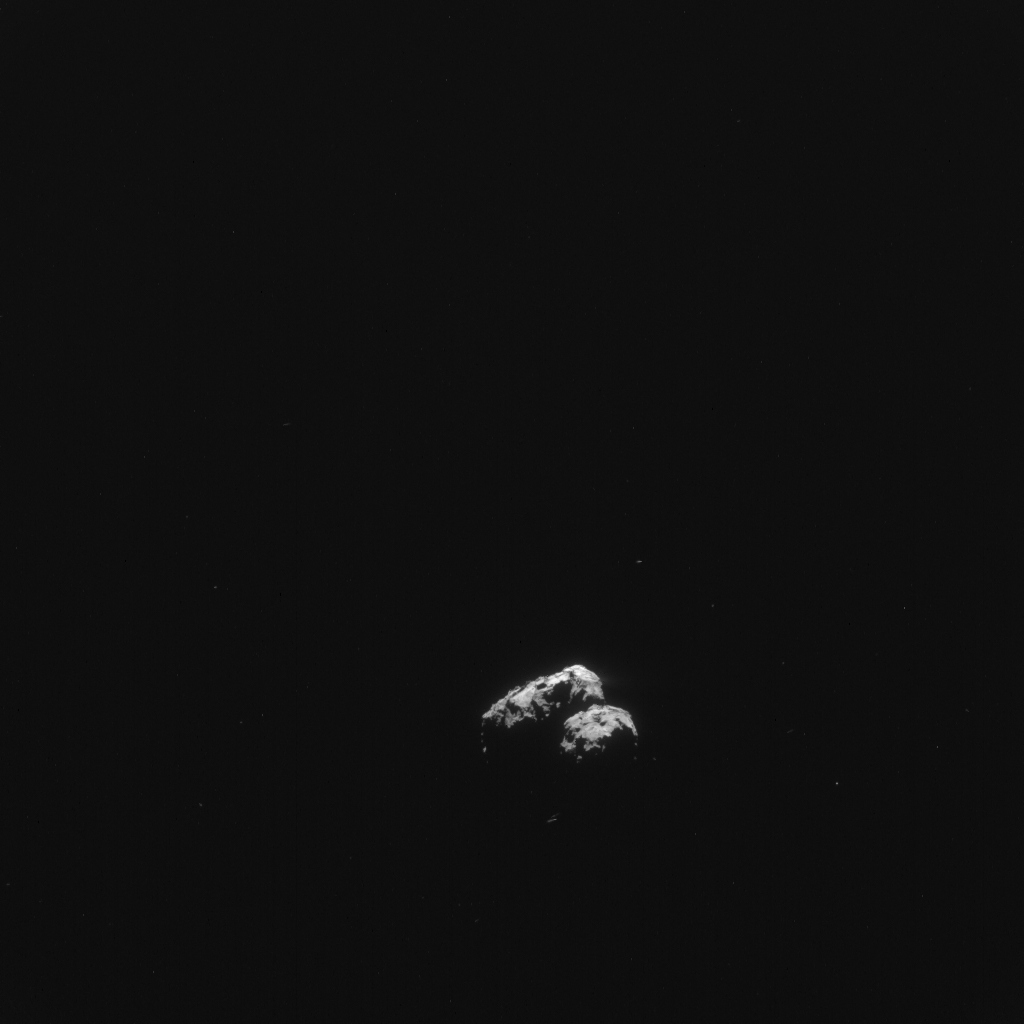This week Rosetta has been moving back towards Comet 67P/Churyumov-Gerasimenko again following its far excursion in the anti-sunward direction to study the wider coma, tail and plasma environment.

Rosetta NAVCAM image of Comet 67P/C-G taken on 4 April 2016 from a distance of 338 km. The image scale is 28.8 m/pixel and the image measures 29.5 km across. Credits: ESA/Rosetta/NavCam – CC BY-SA IGO 3.0
The spacecraft reached ~1000 km on 30 March and is now less than 100 km again. Today’s CometWatch image was taken on the inbound leg of the journey, on 4 April, from a distance of 338 km.
Even at this distance, a number of the comet’s regions can be picked out: notably the flat surface of Khepry to the top right of the large lobe with Aker ‘below’ and Babi to the left in this orientation. On the small lobe, Hatmehit is in shadow to the lower right with parts of Bastet and Ma’at above and to the left.

OSIRIS narrow-angle camera image taken on 29 March 2016, when Rosetta was 820 km from Comet 67P/Churyumov–Gerasimenko. The scale is 14.9 m/pixel. Credits: ESA/Rosetta/MPS for OSIRIS Team MPS/UPD/LAM/IAA/SSO/INTA/UPM/DASP/IDA

OSIRIS wide-angle camera image taken on 3 April 2016, when Rosetta was 442.5km from Comet 67P/Churyumov–Gerasimenko. The scale is 43.6 m/pixel. Credits: ESA/Rosetta/MPS for OSIRIS Team MPS/UPD/LAM/IAA/SSO/INTA/UPM/DASP/IDA
Earlier this week we also saw views from the far excursion through Rosetta’s OSIRIS narrow- and wide-angle cameras, from distances of 820 km on the outward journey (above), and 442.3 km on the return journey (right), respectively.
The spacecraft continues to approach the comet and over the weekend it is set to carry out a zero phase flyby at around 30 km altitude.
The original NAVCAM image is provided below:










Discussion: 36 comments
Emily
This paper entitled, “The Presence of Clathrates on 67P/ Churyumov-Gerasimenko” looks rather important. Are you going to do a Rosetta blog post on it? The results (finding specific clathrates) strongly suggests that 67P was formed closer to the sun than previously thought. It was published on Friday (8th April 2015). It’s from an august group of cooperating institutions.
SwRI news release:
https://www.swri.org/9what/releases/2016/solar-system-clathrate-ices-comet67p.htm#.VwkJlqd4XCR
Paper (not paywalled):
https://advances.sciencemag.org/lens/advances/2/4/e1501781#figures
Hi,
We’re following this story (along with many others) and will likely address this particular topic at a later date.
Emily
Hi A.Cooper,
“The results (finding specific clathrates) strongly suggests that 67P was formed closer to the sun than previously thought.”
I wouldn’t go that far. The likely presence of clathrates just widens the constraints for the comet formation zone.
Hi Gerald,
It would seem odd to me to describe new information or research findings as “widening” constraints. The whole point of this mission was to *narrow* constraints on where 67P and other comets were formed. There indeed appears to be inconclusive evidence that points in different directions. O2 seems to indicate very cold accretion, while these clathrates lean the other way, but not in a definitive way. Rather than getting clear directions from the evidence of Rosetta as to whether the Asteroid Belt, Kuiper Belt, Scattered Disc, or Oort Cloud is the formation zone for 67P, the evidence muddies the waters we were hoping would become clearer. I suspect something fundamental in the narrative is wrong. Probably in the sense that comets are not pristine remnants. Perhaps that is the constraint that needs widening.
Hi Marco,
we’ll get both, new unconsidered scenarios, and additional constraints, as data and understanding evolve.
Comets are of interest, because they are suspected to be the most prestine minor bodies in our solar system. This doesn’t mean, that they need to be perfectly prestine.
How prestine they actually are, is certainly a research objective.
Hi Gerald,
I think all the evidence from comets since Giotto point to comet nuclei being the most processed objects in the solar system. That is that they are the least pristine.
Saying that they need not be “perfectly pristine” presumes that our pre-Giotto assumptions were confirmed since by the space probes, while observations , as I have said before, far from being predicted by our assumptions.
One cannot start with the assumption that they are pristine and still prove that they are the opposite of pristine.
Yes there are myriad parameters that could allow for comet nuclei being pristine in some way, but there are also myriad parameters that could allow comets to be not at all pristine…
Hi Marco,
not quite sure, how you understand “prestine”. Of course, in an absolute sense, they are as old as Earth. But they didn’t undergo the kind of alterations we see on planets, like extended melt-up or aqueous alterations.
Most of the grains found on comets didn’t undergo much alterations since the accretion of the comets about 4.5 billion years ago.
Due to the sublimation/erosion much of the crust altered by energetic radiation is lost, and some of the deeper protected layers are going to be exposed to the surface, and are accessible for sampling.
On planets all the initial ingredients have been molten up many times, sedimented, altered by liquids and the atmosphere. So it’s very hard to find old material, e.g. on Earth.
On Mars you can go back until about 4.0 billion years ago.
Venus surface is young due to periodic large-scale volcanism.
Earth rock is mostly up to about 500 million years old. Very few samples are much older.
Moon can be dated back by samples.
With radionuclid methods it’s mostly possible to narrow down the time, when a sample has been molten or solved in a liquid the last time. So age determination isn’t just guesswork and opinion, but a result of isotopic analysis.
https://geomaps.wr.usgs.gov/parks/gtime/ageofearth.html
https://en.wikipedia.org/wiki/Oldest_dated_rocks
Hi Gerald,
Correct me if I am wrong, but to my knowledge, such tests have not been done for comets, as no sample has been returned to Earth, and space probe tests are not rigorous enough to be conclusive either way..
My thought experiment is thus, that if a sample is returned to Earth and is found to have been molten or in solution or both, quite recently, this would say nothing about the material in the core of the nucleus anyway – One can say that the crust has been altered and is recent, but the core is presumably not. Presumption is the problem here. Just as there are myriad ways the crust can be heavily altered while the core stays pristine, there are myriad ways that none of it is pristine, and still consistent with all data.
The key is the low density. One of the key arguments in favour of pristine-ness is the argument that a fragment of a much larger body cannot have such low density. I am categorically saying that a fragment of a Pluto kind of object can easily become low density as a fragment from a collision that causes it to foam into a low density structure. That is but one example, and it doesn’t take fiction to think of other plausible mechanisms. The problem is that we are locked into thinking that it *has* to be pristine despite having no direct evidence (such as those you cite for Earth, Moon, Mars etc.) for that premise.
Hi Marco, why not both? why not a lot more?
Should that proto-disk be pristine stellar material only, created in a ‘perfect’ former void?
“Probably in the sense that comets are not pristine remnants. Perhaps that is the constraint that needs widening.”
Like your wander ending 🙂
Found some [2014!] Research about it:..
“The second scenario is that the rocky particles originally grew inside a previous generation of cores or perhaps even protoplanetary disks. The material could then have escaped back into the surrounding molecular cloud rather than becoming part of the original newly forming star system.”
Rinse, repeat, many times… 🙂
“The large dust grains seen by the GBT would suggest that at least some protostars may arise in a more nurturing environment for planets, [and comets?]” said Scott Schnee [et al.], an astronomer with the National Radio Astronomy Observatory (NRAO) in Charlottesville, Virginia. “After all, if you want to build a house, it’s best to start with bricks rather than gravel, and something similar can be said for planet [and comet?] formation.”
Betting that when research begin at the centimeter scale, those ‘bricks’ are going to be found, also.
via https://phys.org/news/2014-08-orion-pebble-size-particles-jump-start-planet.html
Should be considered that proto-disks are generally less efficient at keeping their surrounds ‘clean’ of interactions with the interstellar medium, than more mature planetary systems..
[Starting by the simplest fact of surface exposure]. 😉
Hi Gerald
Please see my reply to ianw16 on the colour-changing comet thread. It explains why the authors are constraining rather than widening the formation zone.
Hi A.Cooper,
I disagree, since there is more than one reaction path for the formation of clathrates.
Hi Gerald
The paper doesn’t refer to another reaction path unless you’re referring to different possible temp/pressure phases in the PSN. The paper excludes those by constraining the PSN pressure to that of the observed molar relative abundances in 67P. The relative abundances constrain the PSN pressure at formation to be such that clathrates would be formed during cool down and use up all the available volatiles in that process. So by the time the temperature was conducive to amorphous ice formation, there would be no material for its formation because it was all tied up in the clathrates.
The authors then went on to use PSN pressure scenarios based on the molar relative abundances in several other visited comets. These gave a similar result and constrained the formation of the clathrates to being between 44K and 50K. All abundance/PSN pressure scenarios precluded amorphous ice condensation which has to be at a much lower temp.
However, they don’t say how relative molar abundances can be translated to PSN pressure (unless it’s in the supplementary pages). I would have thought you could plonk those abundances at any radius in the PSN and get a different pressure value. It would become a circular argument to say that they were assumed to be at a certain radius resulting in a certain pressure and therefore must have come from that radius. But I’m quite sure it is I who is missing something there and not the authors.
Like a lot of the papers coming out, this is based on poorly understood abundances (which the authors acknowledge to be the case), and poorly understood PSN dynamics. But it’s a start and it shows a way in which the comet could have been formed much closer in. It therefore behoves others to refute this hypothesis in order to keep CB theory alive or at least out of intensive care. That’s why I said it’s a “compositional problem”. As long as it’s around, it’s a thorn in the side of CB theory.
Hi A.Cooper,
citing the discussion section of the paper
https://advances.sciencemag.org/content/advances/2/4/e1501781.full.pdf
Our results do not exclude the existence of amorphous ice in the solar nebula, which may have been quite abundant in the low-temperature, outer regions of the disc [for example, (4, 30)]. In addition, the presence
of clathrates in the nucleus of 67P does not prove that comets, including 67P, formed out of clathrates
This means, that clathrates can also form from intimately mixed water ice and ices of the gasses.
As long as there are no further constraining results, I’d consider that nature might have done it the most inconvenient way (for us), meaning both paths might have occurred, so some mix of amorphous water ice (plus other volatile ices) from the outer regions of the solar system, and some clathrate crystals from a zone closer to the sun mixed by turbulences, before the protoplanetary nebula “cooled down” (in the dynamic sense) to a protoplanetary disc allowing for accretion of small bodies.
Gerald
[Glossary for others:
PSN: proto-solar nebula.
ISM: interstellar medium.
CB theory: contact binary theory (although, 67P’s CB status has been stated as being “unambiguous”, a bold claim, so perhaps I shouldn’t call it a theory?]
/////
Gerald
I’ll help you in making your point by quoting the relevant sentence:
“Clathrates could also form later in the nucleus in the presence of free crystalline H2O ice, even if the original ice phase of 67P was amorphous H2O.”
So it wasn’t the PSN phase issue I mentioned but the later formation of the clathrates within the cometary environment. I overlooked that in my recollection. However, the discussion does emphasise that amorphous ice had previously been thought to play a leading role in the origin of 67P and now it seems that clathrates “may play a leading role” in that origin (as opposed to in its ongoing evolution by forming later) :
“Our results do not exclude the existence of amorphous ice in the solar nebula, which may have been quite abundant in the low-temperature, outer regions of the disc [for example, (4, 30)]. In addition, the presence of clathrates in the nucleus of 67P does not prove that comets, including 67P, formed out of clathrates. Yet, our results, along with other recent efforts supporting the presence of N2, Ar, and CO clathrates in the nucleus of 67P (31, 32), suggest a picture of the origin of 67P that is different from what was envisaged before, where crystalline H2O ice, pure condensates, and clathrates, rather than amorphous ice, may play a leading role.”
If they had simply found amorphous ice it would be ISM origin, end of story. But it is this possible “leading role” of clathrates that will now be a thorn in the side of the CB narrative. That’s because it could mean 67P formed in the bowling alley of the PSN instead of in splendid isolation in the ISM (well, err…two comets in splendid isolation…but right next to each other, mind…and isolated at the same time…going at the same speed…and direction…and made of special ice that can withstand 10x the specific KE dissipation as in that modelled version using tiddly 1km rocks…but let’s not start another bun fight 🙂 )
Another excerpt (which is the full paragraph from which I culled my opening quote) carries a tone that’s at best undecided and at worst, slightly negative regarding the later clathrate formation (as opposed to during formation). It depends whether they are intimating that the “significantly shorter time scales” are an obstacle.
“The kinetics of clathrate formation at low temperatures are not well known, but the nature of the differences in prevailing thermody- namic conditions (P, T) in the PSN versus the ISM makes it more likely that clathrate will form in the former as opposed to the latter (5). Clathrates could also form later in the nucleus in the presence of free crystalline H2O ice, even if the original ice phase of 67P was amorphous H2O. If clathrates formed in the nucleus of 67P at a later period after the comet’s formation, then clathration would have had to occur on significantly shorter time scales than the formation of crystalline H2O and clathrate ice grains in the PSN. Unfortunately, the currently loosely constrained kinetics of clathrate formation (29) do not allow us to distinguish between a nebular and a postnebular for- mation of clathrate in 67P.”
I like your idea of picking up amorphous ices far out and also clathrates further in. And of course, the irony of all this is that stretch theory doesn’t really care where the formation took place (though Marco may disagree). It’s CB theory that does care. And I should just emphasise that stretch theory also doesn’t depend on killing off CB theory. It has its own independent evidence which (for those who have seen the matches and suddenly realise all that supposedly random raggedness is in fact highly ordered), means that CB theory is untenable anyway.
Analysis of background stars, camera pointing, geometric camera calibration, etc.:
https://nova.astrometry.net/user_images/1066940#redgreen
Hi, Emily. Unlike the sun-ward shots, dominated by ‘crown’ like jets visibility, this eclipsed perspective allow contemplation of the more subtle ‘lattice’ emissivity.
https://www.esa.int/spaceinimages/Images/2016/04/Comet_on_29_March_2016_OSIRIS_narrow-angle_camera
Logan: There is a small region near the neck on the bigger lobe which does not appear to be lighted by direct sunlight. Is it by reflected light from the smaller lobe? Or does the dust play a role?
Hi Kamal. Too much photons. Betting same as your first bet.
At no point of Her entry Emily signal this photo as an eclipsed view. Assumption only mine.
As in the past signaled NAVCAM shot, huge areas at the ‘night hemisphere’ illuminated. Also speculating tails enacting as ‘moonlight’.
Kudos OSIRIS Team! 🙂
Today’s OPOD (taken on April 9/10) reminds me of the rays seen on the full moon.
OSIRIS Teamwork causing total awe again!.
https://planetgate.mps.mpg.de:8114/Image_of_the_Day/public/OSIRIS_IofD_2016-04-12.html
Any Soul still asking for an ‘icy’ look?
Had not observed this surface properties since that selfie of ROSETTA shadow.
“The [interstellar] grains all had a surprisingly similar chemical make-up, containing major rock-forming elements like magnesium, silicon, iron and calcium in average cosmic proportions.”
“Conversely, more reactive elements like sulfur and carbon were found to be less abundant compared to their average cosmic abundance.”
“…The authors speculate on how this processing of dust might take place: Dust in a star-forming region could be destroyed and recondense multiple times as shock waves from dying stars passed through…”
These grains from less reactive elements more easily destroyed that those grown|accreted into BIG grains -and eventually pebbles-, made from more reactive elements and sublimates.
Among innumerable cycles, these blasted debris are ‘blown away’ out of Stellar Deposition Zone [SDZ?].
Medium grains remaining at far periphery of SDZ.
Dry, cold small grains becoming interstellar ‘voyagers’, subject even to photonic ‘shock waves’.
Beautiful speculation 🙂
Now understand a little more what Gerald has been chatting about.
This Document also suggest new questions to Star Genealogy.
Thanks a lot to N. Altobelli, F. Postberg, K. Fiege, M. Trieloff and allies..
https://dx.doi.org/10.1126/science.aac6397
via https://phys.org/news/2016-04-saturn-spacecraft-samples-interstellar.html
Could it be that Far Far Stars look younger in part because there is a lot of of “magnesium, silicon, iron and calcium” in the light path toward Us, filtering out their emission spectra?
Extinction of star light by the interstellar medium (ISM) is well-known, and considered in spectrography:
https://en.wikipedia.org/wiki/Extinction_(astronomy)
Emission spectra (and absorption spectra) usually are Doppler shifted (differently), such that absorption spectra of the ISM and emission lines of the stars don’t match::
https://en.wikipedia.org/wiki/Relativistic_Doppler_effect
“…such that absorption spectra of the ISM and emission lines of the stars don’t match”, due to [commonly] differing relativistic speeds?
Yes, speed (not necessarily “very” relativistic, since the lines are narrow), gravitational redshift, and temperature (Doppler broadening).
https://en.wikipedia.org/wiki/Gravitational_redshift
https://en.wikipedia.org/wiki/Doppler_broadening
“…(Doppler broadening)….”
Had not considered that, also.
I speculated some time ago of ‘Doopler narrowing’ Deep within molecular clouds.
… magnesium, silicon, iron and calcium in the light path towards us would need to be in the same state(s) as the atoms/ions in the stars after emitting their photon to be excited by this photon to exactly the excited state, without releasing a “difference photon”, which could be measured.
Note also, that most lines of older stars are absorption lines, not emission lines.
https://cas.sdss.org/dr6/en/proj/basic/spectraltypes/stellarspectra.asp
Hence not too much of a risk to get wrong compositional results of stars due to extinction by the ISM.
Thanks Gerald 🙂
“Previously, the different average extinction curves in the Milky Way, LMC, and SMC were thought to be the result of the different metallicities of the three galaxies…”
….
[Actually,] “…The variations in the curves seen in the Magellanic Clouds and Milky Way may instead be caused by processing of the dust grains by nearby star formation.”
Well, spectra of whole galaxies are little more complicated than those of individual stars.
If only for aesthetic amusement:
“Hi-GAL, the Herschel infrared Galactic Plane Survey: photometric maps and compact source catalogues. First data release for Inner Milky Way: +68° > l >-70° ”
Free Access:
https://www.aanda.org/articles/aa/pdf/forth/aa26380-15.pdf
Via https://phys.org/news/2016-04-herschel-catalogues-reveal-stellar-nurseries.html
Kudos, ESA’s Herschel Mission Teams!